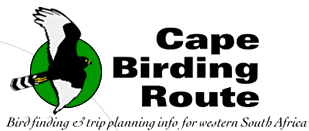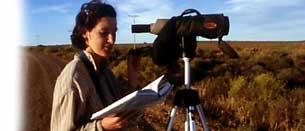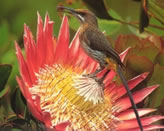Darling
Farmlands and Wildflowers
|

Click
on Map to Enlarge
|
Returning
from Silwerstroomstrand to the R27, continue for a further
9.3 km before turning right onto a gravel road marked
‘Darling Hills Road’ (opposite the conspicuous
‘Grotto Bay’ sign; look for the yellow flags,
1 on site map, above). Clapper
Lark (p.116*) and Southern
Black Korhaan (p.57*) occur in the patch of
vegetation at the junction of these two roads, and are
most conspicuous when they are vocal in spring. Continue
along the Darling Hills gravel road for 0.6 km until
you reach a small pond (dry in late summer) on the left,
where Avocet and Three-banded Plover can
often be seen. Pied Starlings have burrowed their
breeding tunnels into a sandy bank here, and a male
Pin-tailed Whydah often displays overhead.
This area is most active in winter and spring, when
the surrounding wheatlands are filled with birds; after
the summer harvest it becomes progressively drier and
less active. Small numbers of Blue
Crane (p.72*) may be found in the adjacent fields
(2 on map), especially in summer. Red-capped Lark,
Capped Wheatear, Familiar Chat, Grassveld
Pipit and Cape Sparrow are common in this
vicinity. In spring and summer, look overhead for Banded
Martin and Pearl-breasted Swallow among the
more numerous Greater Striped and European
Swallows. |
Continue
along the Darling Hills road, and look out for the small stream
passing under the road at 3. A Masked Weaver colony
is present in the large tree on your right at this point,
and in spring a parasitic Diederik Cuckoo lurks around
its edges. We have seen all three mousebird species
perched in a single bush here! The road continues along a
winding, overgrown river course until you reach a bridge (4).
White-throated Swallow breeds under the bridge, and
the alien vegetation in this vicinity holds Fiscal Flycatcher,
Acacia Pied Barbet and Cardinal Woodpecker.
Titbabbler and Long-billed Crombec may be found
in the remnant natural scrub. Listen out at any stand of exotic
trees in this area for Klaas’s Cuckoo, African
Hoopoe and the scarce Greater Honeyguide. Occasionally,
Secretarybird is seen stalking the open fields along
the road, and Namaqua Dove may be seen in summer. The
route intersects a tar road (the R307; 5 on map); just before
turning left towards Darling, take a quick scan for the Jackal
Buzzard that often perches in this area.

Roadside
birding in the wheatlands of the Swartland, near Darling
|
If
you’re passing through these parts at any time between
August and October, do pay a visit to the Waylands Wildflower
Reserve (6) where renosterveld vegetation occurs (see p.7).
The vivid colours and massive diversity of flowering bulbs
are truly spectacular and are sure to impress even the most
hardened of birders. This is also an excellent place to see
Clapper
Lark. In 1998, a major irruption of Black-headed
Canary (p.105*) and Ludwig’s
Bustard (p.105*), two arid-country species normally
found much further north in Namaqualand and the Karoo, occurred
in this part of the Cape. Large numbers of both these species
invaded the area for some weeks, and the canaries even bred
here. Continuing towards Darling, the tiny Oudepos Wildflower
Reserve (7) provides further great birding and flower viewing,
and can be enjoyed from the comfort of your car. You’ll
see the white gateway to the reserve on your left, directly
opposite the R315 turn-off to Malmesbury. A few pairs of Cloud
Cisticola (p.57*) breed here, and Orange-throated
Longclaw, Thick-billed Lark, Grassveld Pipit
and Yellow Canary are also common. A small group of
Spotted Dikkop, which can sometimes be quite difficult
to see, roosts in the gardens near the main building which,
incidentally, is the largest orchid nursery in the southern
hemisphere.
The
quaint town of Darling, home to a number of local artists
including the internationally renowned political satirist
Pieter-Dirk Uys, appears rather unhurried, except perhaps
during the peak flower season. It is an excellent place to
take a short break from birding and enjoy a light meal. Little
Swifts breed in the town and can almost always be seen
wheeling overhead. Cape Canary can also be seen in
the town. The Wildflower Reserve, adjacent to the town itself,
is worth a visit in spring if you have time.
Continue
through Darling along the R315 towards Yzerfontein (poorly
signposted), which eventually intersects the R27. The unassuming
Tienie Versveld Nature Reserve lies on the left at 8. There
are no facilities here, but its presence is betrayed by a
small sign and a stile over the fence. For most of the year,
it resembles an ordinary, abandoned field, but in spring it
undergoes a spectacular transformation, becoming a vast mosaic
of flowers. It is best known among birders as an excellent
site for Cloud
Cisticola (p.57*), which is common in the areas of
taller grass. Common Quail (summer), Thick-billed
and Red-capped Larks, Capped Wheatear, Orange-throated
Longclaw and Grassveld Pipit are also found here.
The seasonally flooded marsh often holds Ethiopian Snipe,
and Blue
Crane (p.72*) is an occasional early morning visitor
to the reserve.
|


